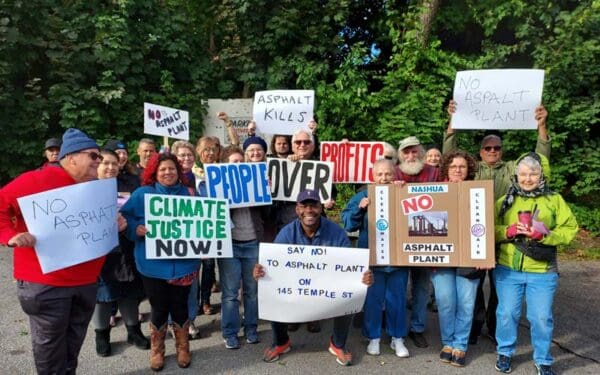
The EPA needs to go further in designating all PFAS as toxic substances. Photo: Shutterstock.
This month, for the first time, the federal government announced it would require municipal water systems to remove six synthetic chemicals from the tap water that hundreds of millions of us drink. The new rule by the Environmental Protection Agency is consequential and a long time coming.
It’s also not enough.
For years, we’ve known that the tap water in many of our communities is tainted with toxic per- and poly-fluoroalkyl substances, otherwise known as PFAS, or “forever chemicals.” These chemicals infiltrate water because they are widely used in consumer, commercial, and industrial products. They may come from industrial facilities where products containing PFAS are manufactured or from landfills containing discarded goods ridden with PFAS. And because these chemicals break down very slowly, they eventually permeate the soil and seep into groundwater.
Decades ago, there was no public awareness about PFAS. But that’s changed. It is now known that these chemicals are hazardous to our health and end up in many places where they don’t belong. Studies show that repeated ingestion of PFAS over a lifetime can cause cardiovascular, immunological, developmental, and reproductive disorders. They may cause growth and behavioral problems in children and kidney and testicular cancer in adults.
Nevertheless, these chemicals now pervade everything around us. They have been detected in air, soil, fish, clouds, snow samples taken from Mount Everest, and human blood.
For these reasons, the EPA must go beyond limiting how much PFAS is allowed in our tap water. It must now designate all PFAS as toxic pollutants under the Clean Water Act, not only the two PFAS chemicals it designated as hazardous chemicals this month. It must also close the regulatory loopholes that allow new PFAS on the market without a safety review. That’s the decisive action we need to protect people, wildlife, and the planet.
Until the federal government takes comprehensive action, CLF and our allies are pushing states to limit the presence of PFAS in our lives–and we’re succeeding.
This month, the Vermont House advanced legislation to ban PFAS from personal care products, menstrual products, apparel, cookware, artificial turf, and children’s products. Also, this month, New Hampshire legislators voted to ban PFAS in many consumer products sold in that state. Given the magnitude of the problem, this action is long overdue.
The chemical industry has shrewdly evaded regulation for years, which explains why asbestos and trichloroethylene, or TCE, are still used in commercial and industrial applications in the United States, even though they are highly carcinogenic and have been almost completely banned in the European Union. How long can we allow industry to put public health at risk in the name of profit? Now is the time for much more stringent standards and a more comprehensive approach.
A World Awash with PFAS
First developed in the 1940s, forever chemicals are now embedded in almost every synthetic material we encounter today. Over 14,000 PFAS chemicals coat products like cookware, fire-fighting foam, water-repellent clothing, stain-resistant fabrics, upholstery, food paper wrappings, cosmetics, soft contact lenses, laundry detergent sheets, and much more. Given their pervasiveness in our human-made world, it was only a matter of time before these chemicals would migrate into the natural world and, most notably, our drinking water.
Across New England, communities in every state have discovered PFAS in drinking water. In New Hampshire alone, the City of Portsmouth shut down a public drinking water well after finding high levels of PFAS in 2016, and communities in Merrimack, Dover, Rochester, and Hampton have grappled with their problems, too.
States have taken varying approaches to the issue, with some, like Massachusetts, Maine, and Rhode Island, strictly limiting PFAS in drinking water because of CLF’s advocacy. In contrast, others, like Connecticut, have failed to set standards for drinking water at all. (For the record, Connecticut did pass a law banning “intentionally added” PFAS in food packaging last year.)
The new EPA standard seeks to address this problem by setting a new federal maximum contaminant level allowable in drinking water. And the EPA’s step to designate two chemicals as hazardous under the Superfund law means polluters, not taxpayers, will pay for the cleanup. But unless more is done, their action is just one drop in an ocean filled with PFAS.
Time to End the Problem at the Source
Fortunately, more people are beginning to wake up to the risks the chemical industry is throwing our way. As we have seen this month, legislators are acting accordingly. But this problem cannot be solved piecemeal, state by state. The large companies producing our consumer products sell across state lines, and rivers and streams flow across state lines, too.
With people’s health at risk and knowing that these chemicals build up in the environment and our bodies over time, a much more restrictive approach to PFAS is not only warranted but necessary. That’s why CLF will continue to press forward on getting these dangerous chemicals out of our lives. No one should be exposed to the hazards of dangerous forever chemicals as they drink a glass of water, eat a meal, or don a raincoat. We can do something about the PFAS problem, and treating forever chemicals as the hazards they truly are is the best way to get started.




